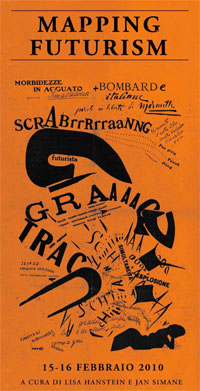Mapping Futurism
February 15-16, 2010
Florence, Italy
Kunsthistorisches Institut in Florenz – Max-Planck-Institut
Mapping Futurism
15-16 February 2010, Kunsthistorisches Institut in Florenz – Max-Planck-Institut
At the end of the centenary celebrations marking the publication of the first Futurist Manifesto in 1909, the Kunsthistorisches Institut in Florenz is holding an interdisciplinary Study Day with the aim of examining the role of Italian Futurism within the international avant-garde movements.
The Kunsthistorisches Institut in Florenz – Max-Planck-Institut is furnished with an extensive art-historical library which includes among its holdings on modern and contemporary art in Italy an outstanding special collection of some 500 original publications from the period of Futurism. At the same time the Institute is situated in a historically important centre of Futurism, given that Florentine Futurism firmly opposed the political line represented by the founding father of Futurism, Filippo Tommaso Marinetti, in Milan. So Florence is an ideal place in which to examine the question how far the Futurists really could claim to be precursors of the international avant-gardes, as “primitives of a wholly renewed sensibility”, as they called themselves.
Artistic movements such as Futurism, Cubism, Dadaism and Surrealism radically opposed the traditional concept of art at the start of the twentieth century. Common to them all was the cultural context of a period of revolution and of groundbreaking discoveries in science, technology, psychology and medicine. They were also united by the ambition to create a new kind of art that would correspond to an image of the modern world. Yet at the same time these movements were national developments, each with its own intellectual background. They sprang from the different political situations in the individual countries.
The aim of the Study Day is critically to examine, from an international perspective, the claim of Futurism to have played a leading role in these movements. That claim was proudly enunciated by Filippo Tommaso Marinetti in 1932, when he said that “the artistic revolution begun by the Futurist movement [.] has created or influenced numerous avant-gardes”. The main focal point is the effect Futurist positions – their reception and influence – had on other art forms. The attempts of Futurism to distance itself from other avant-garde movements will also be analysed.
The evening lecture by Linda Dalrymple Henderson on “Boccioni, Futurism and the Energies of Modernism” will conclude the Study Day with a look at common fields of interest of the artistic avant-gardes at the start of the twentieth century. Apart from new scientific discoveries, her lecture will focus, among other things, on late Victorian ether theory and occult phenomena as sources of energy and inspiration for Futurist artists.
The proceedings of the Study Day will be published in the Florentine journal Semicerchio. Rivista di poesia comaprata in its next issue, which will be dedicated to the impact of the Italian avant-garde in Holland, Poland, France and the USA.
Pro Firenze Futurista – Digital Archive on Futurism in Florence
The Study Day will open with a presentation of the website Pro Firenze Futurista, a project of the Library of the Kunsthistorisches Institut in Florenz in cooperation with the Biblioteca Marucelliana. The foundation of a Digital Archive on Futurism in Florence will thus be laid and the public provided for the first time with free online access to research materials hitherto difficult to access.
The core of the database will consist of a digitalized text of the complete run of the Florentine journal L’Italia Futurista, which was published in 51 issues between 1916 and 1918 as organ of the so-called ‘Second Florentine Futurism’. This will be supplemented with further documents, such as letters, books, photographs, films and audio-visual materials on individual artists, poets and intellectuals who contributed to the journal and helped to generate the avant-garde development in Florence.
In addition, the website will offer thematic portals in which documents on selected themes will be ready-assembled and made available in bundled form, as for instance on the English poet and artist Mina Loy, who frequented the group of young Florentine Futurists round the journal Lacerba (1913-1915). After her stay in Florence she was acclaimed as an ambassadress of Futurism in the USA, but remains largely unknown in Italy.
With its joint project Pro Firenze Futurista, the Library of the Kunsthistorisches Institut is reinforcing cooperation between Florentine research institutions – the Biblioteca Marucelliana, the Fondazione Primo Conti and the Gabinetto Scientifico Letterario G.P. Vieussieux are already partners. In addition the Fondazione Longhi and the pianist and composer Daniele Lombardi have promised their support. Further partners, who would like to contribute to the building up of the Digital Archive, are welcome.
